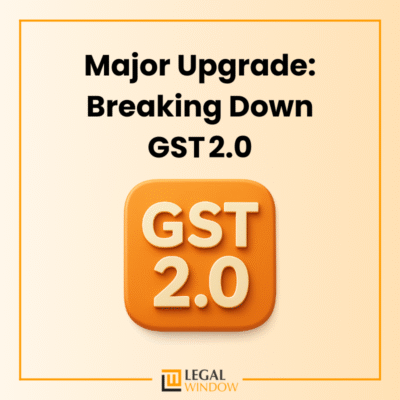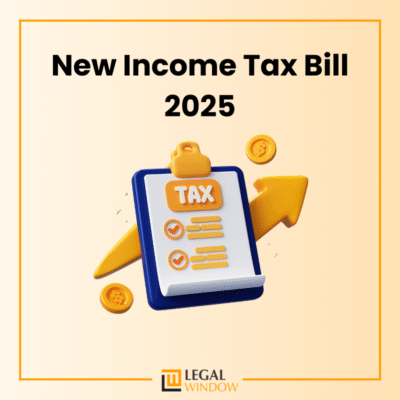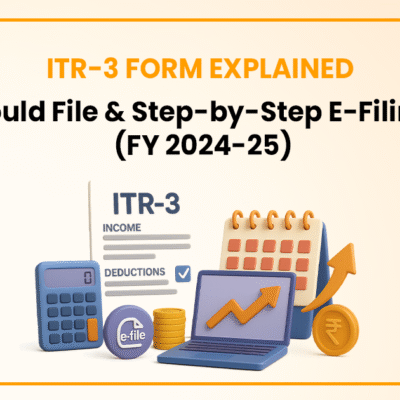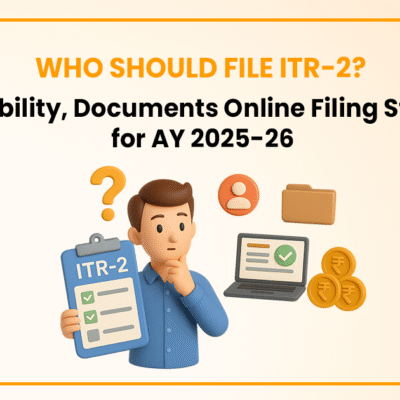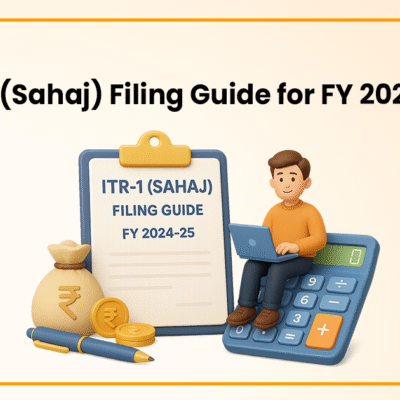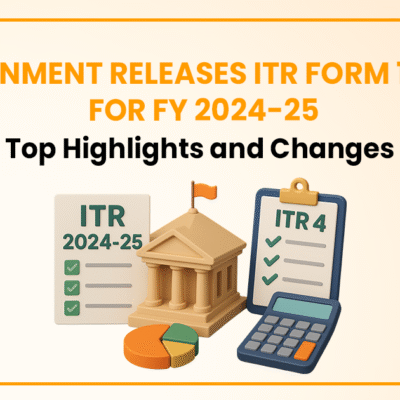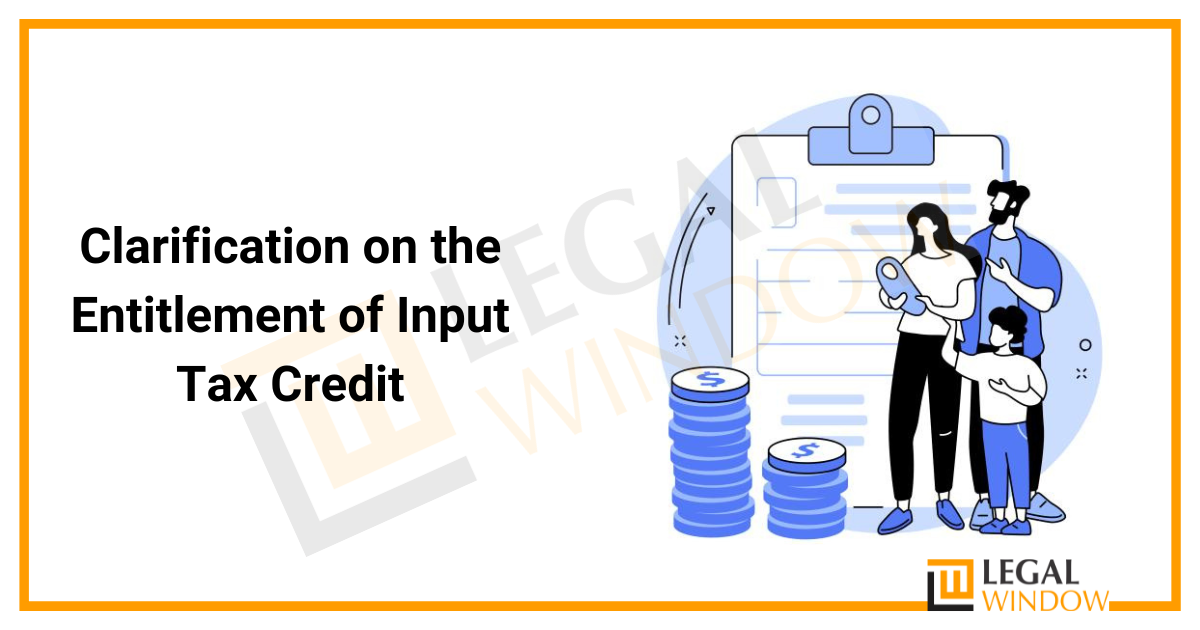
You must pay sales taxes when you buy a product or service from a dealer. This tax is collected when you sell. You subtract the taxes paid at the time of purchase from the amount of production tax (tax on sales), and the difference is payable to the government. This is referred to as Input Tax Credit use. The Central Board of Indirect Taxes and Customs (CBIC) has issued a clarification on the eligibility to Input Tax Credit (ITC) when the site of delivery of services by means of transportation of products, including by mail or courier, and where the provider and recipient of services are both in India. This clarification was issued on 27th December 2022. This article briefly describes the Clarification on the Entitlement of Input Tax Credit, & the Procedure of claiming Input Tax Credit.
| Table of Content |
Quick Look
The CBIC published Circular No. 184/16/2022-GST on December 27, 2022, clarifying the claim to input tax credit when the location of supply is established in accordance with the proviso to sub-section (8) of Section 12 of the Integrated Goods and Services Tax Act, 2017 (“the IGST Act”). Subsection (8) of Section 12 of the Integrated Goods and Services Tax Act, 2017 (hereinafter referred to as the “IGST Act”) provides for the place of supply of services by way of transportation of goods, including by mail or courier, where both the supplier and the recipient of services are located in India.
Some Basic Notion about Input Tax Credit under GST
The Input Tax Credit is a significant concept in GST since it reduces the tax’s diminishing effect. Under certain restrictions and situations, a registered person is entitled to GST credit due on imported commodities or services and capital items. The registrant may utilize the input tax credit to pay taxes on products or services delivered by him or her.
The term “Input Tax Credit” (ITC) refers to a tax that has already been paid when goods and services are purchased and is available as a tax deduction.
As an example, suppose a trader purchases an item worth 100 rs and pays a 10% tax on it. And now this merchant has sold such things for Rs. 150 while collecting an Rs. 15 tax from the buyer. The dealer must now pay the government Rs. 15. Because he has previously paid Rs. 10, this Rs. 10 is the trader’s ITC, and he will be accepted as a taxpayer and must pay a total of Rs. 5 in tax.
If you are subject to the GST Act, 2017 you can use the Input Credit Mechanism.
This implies that if you are a registered GST manufacturer, supplier, agent, e-commerce operator, aggregator, or any other individual listed below, you are entitled to earn input credit for your taxes on your purchases.
Procedure of claiming Input Tax Credit
To claim a credit for GST inclusion –
- A tax (purchase) invoice or debit note issued by a registered dealer is required.
- You should have gotten your goods/services by now.
When items are purchased in lots/installments, a credit based on the tax invoice will be available upon receipt of the last portion or installment. If the receiver does not pay the service amount or tax within three months of receiving the invoice and has already received the input credit, the indicated credit will be applied to his/her output tax and interest liabilities.
- The provider pays the government tax on your purchase in cash or by claiming credit input.
- The provider or supplier has submitted their GST Returns.
- The invoice was posted to the provider’s GSTR-1 by the GSTR-2B receiver or customer.
One alteration that may contradict the GST system is allowing credit input only if your supplier has not collected tax for you. So, before you claim any input credit, it will be compared and confirmed. As a result, in order for you to claim Input Credit, all of your suppliers must be GST-compliant. There is a lot to learn about input credit –
- You might have unused input credit. Because the purchase tax exceeds the sales tax. In that situation, you have the option of continuing or requesting a refund.
- Only under extraordinary situations, as defined in Section 18, can the Input Tax Credit be deducted from purchase invoices for more than one year (1). Time is determined beginning with the date of the tax invoice.
- Because GST is levied on both products and services, the credit for installation can be collected for both (except those listed in the exempt list).
- Larger assets/capital assets are eligible for the Input Tax Credit.
- Personal use products and services are exempt from input tax.
- No entrance tax credit will be allowed after applying for a GST refund in September after the end of the fiscal year unless the receipt pertains to the applicable annual rebate filing, whichever is sooner.
ITC Blocking and Reversal in Specific Circumstances
In general, a registered person is entitled to a tax credit for the internal resources that he or she gets. However, some products and services, such as personal use, club membership, health care, and eligibility, are not eligible for the inclusion tax credit.
If the recipient does not pay the supplier for the number of goods or services and tax owed within 180 days, the input tax credit that he or she currently obtains will be canceled. When repaying the input tax credit, the receiver must also pay interest on the amount taken from the credit. The beneficiary may be able to reclaim the entrance tax credit by paying the value of the goods or services as well as the tax due. In addition, there are several circumstances in which a registered person is required to alter the ITC he or she desires, such as when the supplier selects the design process, big assets are sold, registration is terminated, and so on. In certain circumstances, the creditor will go to great lengths to delay the obligation within the term specified. If he does not refund the obligation, he will be required to pay interest and penalties in addition to the ITC amount taken.
Clarification on the Entitlement of Input Tax Credit
The CBIC published Circular No. 184/16/2022-GST on December 27, 2022, clarifying the claim to input tax credit when the location of supply is established in accordance with the proviso to sub-section (8) of Section 12 of the Integrated Goods and Services Tax Act, 2017 (“the IGST Act”).
Subsection (8) of Section 12 of the Integrated Goods and Services Tax Act, 2017 (hereinafter referred to as the “IGST Act”) provides for the place of supply of services by way of transportation of goods, including by mail or courier, where both the supplier and the recipient of services are located in India.
According to clause (a) of the aforementioned subsection, the site of delivery of services by way of transportation of products, including by mail or courier, to a registered person should be such a registered person’s location. However, a proviso to the aforementioned sub-section added by the Integrated Goods and Services Tax (Amendment) Act, 2018 with effect from 01.02.2019 specifies that where items are transported to a location outside India, the place of provision of the said service should be the location of such goods.
In such cases, because the place of supply of services, according to the proviso to sub-section (8) of Section 12 of the IGST Act, is the concerned foreign destination rather than the State in which the recipient is registered under GST, concerns have been raised about the availability of input tax credit for the said services to the recipient located in India.
To clarify this issue and ensure uniformity in the application of legal provisions across field formations, the Board, in the exercise of the powers conferred by Section 168 (1) of the Central Goods and Services Tax Act, 2017 (hereinafter referred to as “CGST Act”), hereby clarifies the following issues:
| Sr. No. | Scenario | Clarifications |
| 1. | What is the place of supply of the said services in the event of the provision of services by way of transportation of products, including by mail or courier, when the transportation of goods is to a place outside India and the provider and recipient of the said supply of services are both located in India? | When both the provider and the recipient are located in India, the place of supply of services by way of transportation of goods, including by mail or courier, is determined in accordance with sub-section (8) of section 12 of the IGST Act, which reads as follows: “(8) The place of supply of services by way of transportation of goods, including by mail or courier to,—
Consequently, in cases where the provision of services is made by the delivery of products, including through the mail or courier, where the destination of the delivery of the goods is outside of India, and where the supplier. According to the proviso to sub-section (8) of section 12 of the IGST Act, which was added by the Integrated Goods and Services Tax (Amendment) Act, 2018 with effect as of 01.02.2019, and the recipient of the said supply of services is located in India, the place of supply is the relevant foreign destination where the goods are being transported. As an example, consider the case of X, a West Bengal resident who is registered for GST and who wants to export products to Y in Singapore. X uses the services of air cargo operator Z, who is likewise registered for GST in the state of West Bengal, to have items transported by air to Singapore. According to the proviso to subsection (8) of section 12 of the IGST Act, the location of the services Z rendered to X in this case was Singapore, the location of the goods. |
| 2. | In the instance presented in Sl. No. 1, will the supply of services be considered as inter-state supply or intra-state supply? | The aforementioned supply of services would be regarded as an inter-State supply under sub-section (5) of Section 7 of the IGST Act since the provider is located in India and the place of delivery is located outside of India. As a result, an integrated tax (IGST) would be levied on the aforementioned provision of services. In the case of the instance in Sl. No. 1 above, Z would charge IGST to X under sub-section (5) of Section 7 of the IGST Act for the delivery of services by way of transportation of goods. |
| 3. | In the scenario stated in Sl. No. 1, is the recipient of the service of transportation of goods eligible to claim an input tax credit for the abovementioned input service of transportation of goods? | Section 16 of the CGST Act specifies the eligibility and requirements for claiming an input tax credit, whereas Section 17 of the CGST Act specifies the apportionment of credit and blocked credits in certain cases. The abovementioned requirements of legislation do not preclude a receiver in India from claiming input tax credit if the place of supply of the relevant input service is outside India. Thus, the beneficiary of a transportation service shall be able to claim an input tax credit for the IGST levied by the provider, subject to the fulfillment of other requirements set out in sections 16 and 17 of the CGST Act, 2017.
In the example given in Sl. No. 1, X would be qualified to claim IGST input tax credit in respect of services obtained from Z, subject to the fulfillment of additional requirements outlined in Sections 16 and 17 of the CGST Act. |
| 4. | In the case of Sl. No. 1, what state code must be stated by the provider of the said service of transportation of goods, where the transportation of goods is to a location outside India while reporting the said supply in FORM GSTR-1? | The service provider must disclose the location of the service by selecting ’96-Foreign Country’ from the list of codes in the drop-down menu provided on the site in FORM GSTR-1. |
Takeaway
The proper officer will ask the claimant to present a certificate from the concerned supplier stating that the aforementioned supplies have actually been made by him to the said registered person and that the tax on said supplies has been paid by the said supplier in his return in Form GSTR 3B. This only applies in cases where the difference between the ITC claimed in FORM GSTR-3B and that available in FORM GSTR 2A of the registered person in respect of a supplier for the said financial year is up to Rs 5 lakh.
It should be emphasized that the explanations provided below are case-specific and apply to the legitimate reporting mistakes made during the fiscal years 2017–18 and 2018–19. These recommendations should not be utilized in interpreting the law because they are just clarifying in nature and may be implemented depending on the specific facts and circumstances of each case.
Here is the Tip for you; you can also connect with our Experts at Legal Window regarding Clarifications on the Entitlement of the Input Tax Credit.
LegalWindow.in is a professional technology driven platform of multidisciplined experts like CA/CS/Lawyers spanning with an aim to provide concrete solution to individuals, start-ups and other business organisation by maximising their growth at an affordable cost. Our team offers expertise solutions in various fields that include Corporate Laws, Direct Taxations, GST Matters, IP Registrations and other Legal Affairs.
Categories
- Agreement Drafting (23)
- Annual Compliance (13)
- Change in Business (37)
- Company Law (150)
- Compliance (90)
- Digital Banking (3)
- Drug License (4)
- FEMA (17)
- Finance Company (42)
- Foreign Taxation (9)
- FSSAI License/Registration (15)
- GST (124)
- Hallmark Registration (1)
- Income Tax (214)
- Latest News (36)
- Miscellaneous (170)
- NBFC Registration (8)
- NGO (18)
- SEBI Registration (6)
- Section 8 Company (10)
- Start and manage a business (27)
- Startup/ Registration (134)
- Trademark Registration/IPR (48)
Recent Posts
- Major Upgrade: Breaking Down GST 2.0 September 15, 2025
- New Income Tax Bill 2025 August 27, 2025
- ITR-3 Form Explained: Who Should File & Step-by-Step E-Filing Guide (FY 2024-25) June 25, 2025
All Website Tags
About us
LegalWindow.in is a professional technology driven platform of multidisciplined experts like CA/CS/Lawyers spanning with an aim to provide concrete solution to individuals, start-ups and other business organisation by maximising their growth at an affordable cost.


